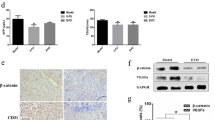Summary
In order to investigate the inhibitory effects on the vascular endothelial growth factor (VEGF) expression and cell growth in hapatocellular carcinoma (HCC) by blocking HIF-1α and Smad3 binding site in the VEGF promoter, antisense oligodeoxynucleotides (ASODN) were designed to block HIF-1α and Smad3 binding site in the VEGF promoter. Different concentrations of ASODN and ODN were transfected into HCC cells respectively. The expression of VEGF mRNA and protein was detected by SABC, Western blot and RT-PCR techniques and the inhibitory effects on the expression of VEGF and cell growth of the HCC cells stimulated by the supernatants were determined by using MTT method. Immunohistochestry revealed that after co-inoculation of hepatocellular carcinoma cells with different concentrations of ODN and ASODN for 48 h, there was no significant difference in the expression of VEGF protein between ODN group and control group (P>0.05), but there was significant difference between ASODN, the difference was very significant (P<0.01). Western blot and RT-PCR revealed that, after treatment for 48 h at a concentration of 10 μmol/L, the integral gray levels and RNA odds were 59743.2±10412.5 and 0.783±0.032 in ODN group, and 38694.5±10925.1 and 0.468±0.015 in ASODN group, respectively, with the difference being very significant (P<0.01). Antisense ODN could inhibit the growth of HCC cells in a concentration-dependent manner. It was concluded that anti-gene technique of aiming at HIF-1α action site in the VEGF promoter could suppress the VEGF expression and inhibit HCC cell growth, and it is promising that anti-gene technique works as a new gene therapeutic tool for anti-angiogenesis of HCC.
Similar content being viewed by others
References
Vaupel P. The role of hypoxia-induced factors in tumor progression. Oncologist, 2004, 5:10–17
Stoeltzing O, McCarty M F, Wey J Set al. Role of HIF-1α in gastric cancer cell growth, angiogenesis, and vessel maturation. J Natl Cancer Inst, 2004, 96:946–956
Choi K S, Bae M K, Jeong J Wet al. Hypoxia-induced angiogenesis during carcinogenesis. J Biochem Mol Biol, 2003, 36:120–127
Bracken C P, Whitelaw M L, Peet D J. The hypoxia-inducible factors, key transcriptional regulators of hypoxic responses. Cell Mol Life Sci, 2003, 60:1376–1393
Rapisardr A, Uranchimeg G, Scudiero D Aet al. Identification of small molecule inhibitors of hypoxia-inducible factor 1 transcriptional activation pathway. Cancer Res, 2002, 62:4316–4324
Maxwell P H, Dachs G U, Gleadle J Met al. Hypoxia-inducible factor-1 modulates gene expression in solid tumors and influences both angiogenesis and tumor growth. Proc Natl Acad Sci, 1997, 94:8104–8109
Tandle A, Libutti S K. Antiangiogenic therapy: targeting vascular endothelial growth factor and its receptors. Clin Adv Hematol Oncol, 2003, 1:41–48
Manley P W, Martiny-Baron G, Schlaeppi J Met al. Therapies directed at vascular endothelial growth factor. Expert Opin Investig Drugs, 2002, 11:1715–1736
Zhao Y, Qiu G X. Relationship between vascular endothelial growth factor expression and angiogenesis in osteosarcoma. Zhongguo Yi Xue Ke Xue Yuan Xue Bao (Chinese), 2001, 23:619–621
Sanchez-Elsner T, Botella L M, Velasco Bet al. Synergistic cooperation between hypoxia and transforming growth factor-β pathways on human vascular endothelial growth factor gene expression. JBC, 2001, 276:38 527–38 535
Bian X Y. MTT assay and its application. Foreign Med Sci: Section Clin Biochem Lab Sci (Chines), 1998, 19:83–85
Semenza G L, Roth P H, Fang H Met al. Transcriptional regulation of genes encoding glycolytic enzymes by hypoxia-inducible factor 1. J Biol Chem, 1994, 269:23757–23763
Liu Y, Cox S R, Morita Tet al. Hypoxia regulates vascular endothelial growth factor gene expression in endothelial cells. Identification of a 5′ enhancer. Circ Res, 1995, 77:638–643
Jiang B H, Rue E, Wang G L. Dimerization, DNA binding, and transactivation properties of hypoxia-inducible factor 1. J Biol Chem, 1996, 271:17771–17778
Ding L, Chen X P, Wang H P. Inhibition of hepatocellular carcinoma cell growth by blocking HIF-1α binding site in the VEGF promoter. Acta Med Univ Technol Huazhong (Chinese), 2005, 34:750–753
Author information
Authors and Affiliations
Additional information
DING Lei, male, born in 1971, Attending Physician, M. D., Ph. D.
This project was supported by a grant from National College Doctor Subject Foundation of China (20020487059).
Rights and permissions
About this article
Cite this article
Lei, D., Xiaoping, C., Kai, J. et al. Inhibition of the VEGF expression and cell growth in hepatocellular carcinoma by blocking HIF-1α and Smad3 binding site in VEGF promoter. J. Huazhong Univ. Sci. Technol. [Med. Sci.] 26, 75–78 (2006). https://doi.org/10.1007/BF02828043
Received:
Issue Date:
DOI: https://doi.org/10.1007/BF02828043




